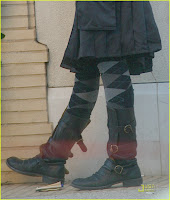 |
| Photo of and by Cam Switzer |
Most of my time is not devoted scholarship (researching and teaching), but to minding schedules, writing "white papers," instituting mandates--most of you know the office gig. What does this have to do with kilts? ...wait for it....
My doctors knew that I was an amateur electric violinist, so both he and she suggested I play more music. I was able to find some musicians with whom I could play every week. Sounds great, but it's hard to schedule. And what does this have to do with kilts? ..wait for it...
Then, my wife was in a horrible car accident: She's recovering well, but we had to sell our two cars, including my beloved Mazda Miata, for one car. She may never drive again, and I don't know about your life, but a one car, two person, two professional, career persons, one car situation appears to me to have the potential to damage a perfectly good marriage. So, what does this have to do with kilts? ..getting tired of waiting for it...
Maybe everything. The women I talk to about clothes often tell me that they pick out clothes to help make (magical power) them feel good about themselves and their day or night. When I talk to men about this, most say that they just grab something clean and get to the task at hand.
In the paradigms of clothing, two stand out.
- Uniforms: Men's clothes tend to be uniforms. Here denotation, for example, the business suit, connotes professionalism, built on mythologies and ideologies of success, power, hierarchy, capitalism, the paradoxes of individualism, and so on. Remember, this is a blog, and I'm just grabbing a few examples. Life is much more complex.
- Costumes: Women's clothes tend to be costumes. Denotations vary widely, as do connotations, but connotations have a twist we don't find in the uniform, for example, connotations can range from invisible, to categories we rarely think of with men such as sexy and even slutty. The mythologies and ideologies that construct "women" and "the feminine" are different: The constitutional and revelatory narratives go back to stories such as Eve in the garden of Eden.
Switching from kilts to business clothes appears, at first glance to be shifting from costume to uniform. I like my business clothes. I have some great dress pants, shoes, formal shirts, funky ties, killer jackets. I can also mix them with jeans, and lots of heavy and dark jewelery. While these clothes are coded as uniforms, I am quite cognizant of the fact that I wear them as costumes because I am clearly putting on a show. I don't know if I can say I'm enacting a guerrilla semiotics, but awareness of expression and perception, being able to push the perception of the beholder (kairos), is a type of communicative power.
Wearing my business clothes as "costumes" short-circuits a beholder's first perception of social subjectivity and lends an objectivity to the body that has the potential to build trust. For example, even when wearing kilts regularly, I would put on a suit and tie when "acting" my "role" as department Chair, meeting prospective students and especially their parents who were preparing to spend quite a bit of money on their child's education. The "appearance" was "packaged" and "delivered" as paralanguage.
So, what happened? By turning to the uniform (and whether my expressive, communicative action was deliberate, the code for suits is uniform) I was able to become invisible. Believe me, people do not hassle you as much as you think they might when you wear a kilt, but you are never invisible. So, this week I wore kilts again. My goal was not to fight depression (you can't do that). You can, however, reconstruct yourself in the image you desire.
While I will continue to argue that women are largely "stripped" of power in our culture, there are sites of power, as there have always been, where "women's" power of expression is more interesting than men's. (I hope I do not have keep saying that there is no "women" as such; I am talking about connotation, myth and ideology not any one real woman).
Is it possible to shift one's perception (when that perception is depressed, everything is dark, and you have what Alan Watts called an inverted mystical experience, things look plastic, getting our of bed is difficult) by shifting one's expression?
My readings in contemporary psychotherapy, cognitive therapy, while being a bit too positivist for my tastes, reveal that "communication" is in fact the site of functional and dysfunctional experience. Phenomenology and semiotics had found this out at least one hundred years earlier, but, what the hay, they deserve credit for finding this out also--and it lends credential to phenomenology and semiotics at the same time. While cognitive therapy focuses on intra-personal and interpersonal communication, the Kilt Guy is going to focus on a wider range of communication. If changing thoughts (e.g., all or nothing thinking) changes the person, does changing clothes change the "person"?











